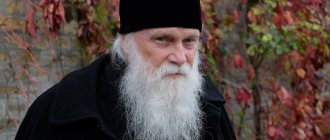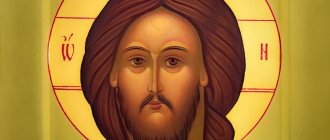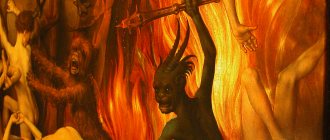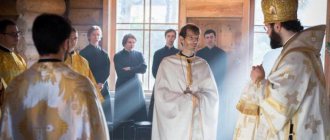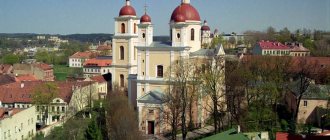From the moment Our Lord Jesus Christ descended to earth and began his preaching, people appeared who, at his word, were ready to leave everything and follow him.
Moreover, if the disciples of Christ - the apostles, set out at the direction of the Savior to preach His word to the peoples of the world, then other followers of Jesus Christ decided to leave the world.
They decided to sacrifice all worldly pleasures, as well as family and property, in order to serve God especially diligently. Such people had and have a special “calling,” that is, an irresistible desire to lead a monastic life, devoting it all to serving God.
How to become a monk: the beginning of the journey
Where to start for a person who has a desire to leave behind the bustle of worldly life and go to a monastery? When wondering how to become a monk, you must first understand what it means. Anyone who makes such a decision must prepare for dramatic changes in life. He will no longer have access to the benefits of civilization to which all residents of the 21st century are accustomed - cell phones, computers, televisions and other achievements of technological progress will remain a thing of the past.
It is important to realize that the life of a monk is dedicated to God, spent in work and prayer. People who have taken monastic vows will have to leave their usual entertainment behind the walls of the monastery. You will also have to give up contacts with the opposite sex. Finally, not every person is ready to accept the fact that he will rarely have to see close people - relatives and friends. It is separation from family that forces many to change their minds.
3) How to deal with covetousness,
with a desire to command. There is a very big problem with female monasticism. These nuns often find themselves involved in parish or diocesan activities, or in general church activities. Here it is very difficult to resist not to start bossing, especially if you are the boss by position (even more so, you need to restrain yourself more), and there may be several techniques here.
One very good rule to remember can be formulated as “keep your head down.” And you just need to remember about the very danger of giving orders. And it’s a joy to meet cases that allow you to humble yourself a little. To rejoice at every such unpleasant occasion, and these include the need for some kind of work, and harassment from the authorities. And, again, here you need to develop for yourself some kind of scheme on how to put the right barriers to your desire to command. It is advisable to develop it not on your own, but in consultation with someone who sees it from the outside.
Communication with a confessor
It is great if someone who plans to enter a monastery has their own confessor. It is he who follows about how to become a monk. In the absence of a confessor, you can visit any church and discuss the decision made with the local priest. From him you can learn details about life in the monastery, which will help you strengthen your desire or change your mind in advance.
As a rule, priests recommend that people who want to say goodbye to worldly life attend church every day for a year. In addition, they must follow fasts, read prayers and make changes in their daily routine. We are talking about getting up early (about 5-6 in the morning), eating lean foods, refusing entertainment, including innocent ones like watching TV shows and using the Internet. Of course, the priest will advise you to give up intimate relationships with the opposite sex in advance.
In addition to all of the above, the future monk is shown reading the Holy Scriptures and becoming familiar with the works of worthy church fathers.
A monk is a person who constantly glorifies God
The word "monk" is of Greek origin. It is translated as lonely, living in solitude, solitary.
Monasticism is a way of life for those Orthodox Christians who decide to devote themselves entirely to prayer and ascetic deeds.
If we consider the theological point of view on the institution of monasticism, then it says that it is a religious-church institution.
It unites those people who decided to isolate themselves from the outside world in order to find an ideal form of serving God.
Video: Venerable Anthony of Pechersk. Series of television programs “The Law of God.” Part 1. About faith and Christian life. The film tells about the life of St. Anthony of Pechersk, the founder of monasticism in Rus'.
In Russia, monks are often called monks, from the word “other.” Monasticism is then called monasticism. There is no direct mention of the word "monk" in the Bible.
At the same time, the Holy Fathers say that the prototype of a monk in the Holy Scriptures can be John the Baptist, who led a solitary life.
The goal of a monk is to constantly praise God in prayer.
In Rus', the founder of Kiev-Pechersk Lavra is considered the founder of monasticism.
The goal of a monk is to constantly glorify the Creator. That is why he leaves the world, so that it does not tempt him and distract him from serving God. In this he is like an Angel, who is always ready to fulfill God's will. The angels constantly praise the Lord, and the monk is constantly in prayer.
V. Tropinin “Monk with a Candle”, 1834. The goal of monastic life is to achieve a state of holiness and receive God's grace
It must always be remembered that the term monasticism in Orthodoxy applies only to those individuals and communities that follow certain rules.
So a monk must take on some vows, for example, renunciation of all the blessings of the world.
In addition, he must obey the rules of the monastery in which he lives or receive a blessing to lead a monastic life in a monastery or cave.
The goal of monastic life is to achieve holiness or spiritual perfection in order to receive God's grace and save the laity.
Labornik
The next stage is for the one who withstands all the tests of the previous stage with honor, which, as practice shows, few can do. Before becoming a monk, the candidate will have to go through the path of the laborer. This is the name of a person who serves as an assistant to clergy. The worker is required to permanently reside in the monastery, and strict adherence to all the rules accepted there is also necessary. In particular, future monks get up at five in the morning, observe fasts, and spend their days at work. They are forced to clean rooms, help in the kitchen or in the garden, and are assigned other tasks. Of course, a lot of time is devoted to prayers.
The workers live in the monastery for about three years, this is necessary in order to strengthen their decision. A person who wants to devote himself to serving God must understand that he will have to work hard physically. This is also true for those who in worldly life were primarily engaged in mental work, have a diploma of higher education, or worked in a leadership position.
In Orthodoxy there are three degrees of monasticism
The Holy Orthodox Church distinguishes three degrees in monasticism:
- Preparation for monastic feat or novitiate.
- The feat itself is monasticism.
- The highest degree of fulfillment of the monastic feat is schematicism.
Collaboration in the Sharovkin Monastery.
Before tonsure, novices are required to pass a test in the monastery, having worked in it. In some monasteries, there are up to six stages of preparation for tonsure. Usually, before entering a monastery, they ask for a blessing from their spiritual father. Moreover, if a person feels ready for a monastic feat, he can come to the monastery on his own.
In any case, before a newly admitted monk is tonsured, he will be put on probation until the abbot of the monastery is convinced of the sincerity and firmness of his decision.
The Orthodox Church distinguishes 3 degrees of monasticism.
In some monasteries there are up to six stages of preparation for tonsure. In any case, all those newly admitted to the monastery or newcomers are obliged to work.
There is a rank of laborers or laborers, that is, those people who live in a monastery “for the glory of God,” but do not have the goal of becoming monks.
A novice or novice has the goal of becoming a monk, so he stays in a monastery in order to study all the intricacies of monastic life.
An example of a monastic charter is the Charter of the Holy Dormition Zhirovichi Stauropegial Monastery. This is what it says about the behavior of newcomers who entered the monastery:
Charter of the Holy Dormition Zhirovichi Stavropegial Monastery.
Ҥ 44. The novice must try in every possible way, abandoning secular habits, to become imbued with the spirit of monastic life, remembering the instructions of St. Basil the Great to beginning monks:
“Have a modest gait, speak distinctly, observe decorum in conversation, eat food and drink reverently, remain silent in front of elders, be attentive to the wise, obedient to those in authority, have unfeigned love for equals and lesser ones, avoid the evil, speak little, collect carefully knowledge, not to talk too much, not to be quick to laugh, to be adorned with modesty" ("Teaching for January 1st to the students of the philosopher Livan")."
Fyodor Mikhailovich Golovin is a novice at the Solovetsky Monastery.
June 10, 1917 A novice has the right to wear a cassock and a scarf. A novice has the right to wear a cassock and a scarf. The seminarian and sexton are accepted into the monastery with the rank of novice.
Any believer can become a novice, but not everyone can take monastic vows. Some people live in monasteries for many years, being in the rank of novice.
Novice
How to become a monk in Russia? You cannot take monastic vows without also going through the novice stage. If, during the three years spent as a laborer, the candidate becomes stronger in his intention, he becomes a novice. To do this, you must submit a petition for admission to the brethren of the chosen monastery. The abbot will certainly grant the request if the future monk was able to demonstrate hard work and patience while living in the temple as a worker.
The novice also resides permanently in the monastery and is given a cassock. The length of the probationary period, during which a candidate for monasticism will have to confirm his readiness to devote his life to God, is determined individually. It is worth knowing that the novice is free to leave the monastery walls at any time, having realized his mistake.
Vows
How to become a monk in Russia? Having successfully completed the path of the novice, a person can finally say goodbye to worldly life. To do this, he will need to take vows that imply renunciation of the benefits of civilization. Traditionally, people who want to enter an Orthodox monastery take four ascetic vows.
- Celibacy. Monks are unable to have sexual contact with the opposite sex; they deliberately reject the opportunity to get married and have children, thereby dooming themselves to a lonely life. However, the walls of the monastery are also open to widowers with adult heirs who no longer need care.
- Obedience. You need to be aware that by entering a monastery, a person actually gives up his own will, the ability to manage his own life. He is required to obey his confessor unquestioningly. It is better not for freedom-loving and proud people who are not ready for humility and obedience to take this path.
- Non-covetousness. What does it take to become a monk, besides this? You will have to give up your property, whether it is an apartment, a dacha or a car. A person entering a monastery must make a donation in its favor. However, it can be symbolic; most of the property is allowed to be left to close people if desired.
- Constant prayer. Of course, certain hours are set aside for offering prayers. However, a person who has taken monastic vows must pray constantly, even while doing physical labor.
Entry into and exit from monasticism. Part 1
The editors of the Pravoslavie.Ru website continue to publish diplomas of graduates of Sretensky Theological Seminary, which began several years ago. Diplomas of graduates of previous years: Hieromonk John (Ludishchev) “Problems of modern man in the letters of confessors of the 20th century”, Yuri Filippov “Revolutionary movement and theological schools of Russia in the late 19th - early 20th centuries”, Maxim Yanyshevsky “Features of the religious life of Soviet Kazakhstan in 1930– 1950" and others, which raised important issues for our time and were written using archival materials, aroused great interest among readers of the site. The series of publications of diplomas of SDS graduates is continued by the work of Hierodeacon Nikon (Gorokhov), a 2009 graduate of the Holy Dormition Pskovo-Pechersk Monastery, “Entering monasticism and exiting it” (scientific supervisor - Archpriest Vladislav Tsypin), dedicated to extremely relevant and topical problems of modern church life. At the same time, the author in his work not only relies on the works of the Fathers of the Church, canonical decrees and research on the history of the Church, but also takes into account the rich experience of the elders and spiritual fathers of the Pskov-Pechersk monastery, and the entire structure of monastic life in it.
There is probably not a single person who does not know or see monks, who does not encounter them in churches, monasteries or in everyday life. Many have monks as relatives, and even more people have confessors or simply acquaintances among monastics. The external side of the monks’ activities, thanks to the media, is quite well known, but some side of their life remains completely unknown to the world. This gives rise to either riddles, or common conjectures, or implausible stories.
The opening of many new monasteries and farmsteads in Russia over the past 20 years has led to the fact that these monasteries began to quickly fill with monks and nuns, which in itself is very gratifying. But, on the other hand, premature tonsures, ill-considered entry into monasticism, the real difficulties of reviving monasteries and an acute shortage of experienced confessors led to the fact that monastic monasteries began to quickly fill with inhabitants who were random and poorly prepared. Many took monastic vows thoughtlessly, without calculating their strength, without testing themselves, without reasoning, trusting in fleeting feelings or the persuasion of strangers, and in general, as it turned out, by mistake. This immediately affected the spiritual level of modern Russian monasteries.
Such omissions were not in vain. Many of the monks began to leave the walls of the monasteries and return to the world, completely neglecting the previously given vows. Unfortunately, this process continues to this day. That is why the purpose of this work, in addition to its historical and canonical aspects, is also to help those entering monasticism determine their path in life, and to remind all those accepting monasticism of the high responsibility that they take upon themselves.
Formation of the monastic tradition
| Monastery of St. mts. Catherine in Egypt |
What is monasticism, monk, monastery?
Every person has to face these questions. But different people form completely different, sometimes opposing, opinions about monasticism. These ideas depend on many factors: on religious beliefs and position in society, on education and upbringing, on everyday and religious experience, etc. In photographs, from the pages of magazines and newspapers, from television and cinema screens, the faces of monks flicker every now and then, on the Internet you can find sites dedicated to monasteries and monastics, and, finally, there is a rich patristic writing, where almost everything is said about monasticism, but the trouble is The problem is that most people don’t have enough time for deep research. The common man, of course, is content with what the media offers him, and sometimes believes that he already knows everything or almost everything about monasticism. Much less common are thoughtful people who begin to read books and special literature on monasticism. And even rarer are those who research the topic to the end, to the primary sources, to the very basics. Usually these people are either the monks themselves, or specialists in the field of monastic writing, church history and culture.
The Holy Fathers call monasticism the science of sciences. Does this mean that monasticism is some kind of secret knowledge, that is, a special kind of science that is taught in monasteries? Or should this expression be understood allegorically? It all depends on who will speak. If a Protestant theologian speaks about monasticism and completely denies its value, then we will hear one judgment, but if a person who himself has walked the path of a monk speaks about it, then we will hear something completely different.
When equating monastic work with the highest creativity or with a special kind of science, the holy fathers were not mistaken. Because monastic work relates to the most intimate, most important and beautiful thing that is in a person - to his soul. And not only to the soul, but also to the entire composition of man: the education of the spirit, the purification of the soul and the asceticism of the body. In a word, to the transformation of the whole person, or, as the holy fathers said, to his “deification.”
Who are monks? If we give a definition based on one name, it will mean: a person living alone. But such a definition does not mean anything, because there are many people who live alone, but, alas, there are no monks. The word "monk" contains more than just the life of a solitary person. Here, for example, is what St. John Climacus says: monks are those who are called to imitate the life of ethereal forces, these are those who in all actions must be guided by the testimony of Holy Scripture, these are those who must constantly force themselves to do every good deed, these are those who must keep their feelings from sinful impressions, and their minds from sinful thoughts[1]. Of course, this enumeration cannot exhaust all ideas about monasticism.
“Those who attempt to ascend to heaven with their body truly require extreme compulsion and incessant sorrow. For labor, truly labor, and great hidden sorrow are inevitable in this feat, especially for the careless.”[2] The Monk John Climacus, the author of a famous book on monasticism, warns the frivolous against rashly entering the monastic path, which he calls cruel and narrow, because those who enter this path seem to plunge themselves into the fire of unforeseen sorrows and temptations. It is better for the weak not to follow this path, otherwise they can suffer greatly, even to the point of death, and instead of benefiting, receive harm: “All those who approach this good deed, cruel and difficult, but also easy, should know that they have come to be thrown into the fire, unless they want an immaterial fire to take possession of them. Therefore, let everyone tempt himself and then eat from the bread of the monastic life, which is with a bitter potion, and let him drink from this cup, which is with tears: let him not fight against himself. If not everyone who is baptized will be saved, then... I will remain silent about what follows.”[3]
A monk is a warrior of the Heavenly King who fights on the front line and, one might say, in the vanguard. It is impossible to retreat, to leave the field - especially: behind - God and the Kingdom of Heaven, ahead - hordes of invisible enemies and a mortal battle, the length of the battle is a lifetime, at the beginning - renunciation of the world, in the middle - a feat, at the end - a reward or disgrace. “Monasticism is the acceptance of lifelong torment, the perception of the consciousness of a martyr, which, of course, rejoices in the struggle and is never satisfied with what has been achieved”[4]. This is what the path of monastic life is.
These are just allegories, but in life everything is much simpler and more imperceptible, but at the same time more complex. Real monastic life can be very different from what you can read about in books, and everyone who wants to follow this thorny path should definitely know about this.
Most often it happens that a modern person who comes to a monastery is shocked by the difference that arises between the ideas that have formed about monasticism in his head and the reality that he actually sees: “People often came to the monastery shocked by something, at odds with the world around them, tired of life’s struggles and hardships, disappointed, looking for consolation, peace and spiritual freedom. But when the monastery gates closed behind them, most often they found neither one nor the other, nor the third. For a person, remaining a person, brought his weaknesses and imperfections with him to the monastery... And in the monasteries, life went on as usual, very different from secular life, but not in everything coinciding with the ideals of monastic service”[5]. Unfortunately, modern monasticism is far from the ideal of monastic life, but modern youth are not Anthony and Pachomius, not Sergius and not Seraphim. As the famous proverb says: “As the world is, so is the monastery.”
This work is intended, rather, to sober up the frivolous part of young people who strive to find a simple way out of their problems in monasticism, or that part of them who, having not found a use for themselves in the world, thinks to find it in a monastery. For true monasticism a vocation is necessary. For only “he who is able to contain, let him contain.”
Foundations of the monastic lifestyle
It is necessary to say a few words about the reasons for the emergence of monasticism in the Orthodox Church. It is known from church history that monasticism as an institution did not arise immediately after the Savior’s sermon, although it is recognized as indisputable that the institution of virgins, which preceded monasticism, arose simultaneously with the Church itself[6]. It was in the mouth of the Divine Teacher that words sounded that predicted the phenomenon in the Church that was to appear in the future: «
For there are eunuchs who were born like this from their mother’s womb;
and there are eunuchs who are castrated from people; and there are eunuchs who made themselves eunuchs for the Kingdom of Heaven. He who can contain it, let him contain it” (Matthew 19:12) .
Of the three types of eunuchs (people deprived of the ability to bear children) listed by the Savior, the last, in the opinion of the holy fathers, indicates monasticism. Thus, monasticism is that type of people who take upon themselves voluntary virginity (abstinence from marital cohabitation) for the sake of acquiring the Kingdom of Heaven.
Metropolitan Philaret of Moscow in “Rules for the improvement of monastic brotherhoods of Moscow stauropegial monasteries” points to the Holy Scripture as the only and absolute basis for monastic vows:
1. one who takes a vow of obedience and renunciation of his own will and his own wisdom must base it on the word of the Lord: “Then Jesus said to His disciples: If anyone wants to come after Me, let him deny himself, and take up his cross, and follow Me” (Matthew 26:24);
2. one who takes a vow of chastity must heed the word of Christ: “He who is able to contain, let him contain” (Matthew 19: 12.) - and the word of the Apostle: “He who is not married cares for the Lord, how he may please the Lord.” (1 Cor. 7:32);
3. The one who takes a vow of non-covetousness must be confirmed in the word of Christ: “Jesus said to him: if you want to be perfect, go, sell what you have and give it to the poor; and you will have treasure in heaven; and come and follow Me” (Matthew 19:21)[7].
Saint Philaret was not the first to claim that this way of life is based on Holy Scripture. For example, St. Basil the Great, when he was looking for a model of perfect gospel life, he concluded that it was actually monastic life[8]. Saint Ignatius of Caucasus made the same conclusions: “The fulfillment of the Gospel commandments has always been and is now the essence of monastic work and residence”; “true Christianity and true monasticism lies in the fulfillment of the Gospel commandments. Where this fulfillment does not exist, there is neither Christianity nor monasticism, whatever the appearance.”[9]. And here are the words of St. Macarius of Optina: “What does monasticism mean? The fulfillment of Christianity consists in fulfilling the commandments of God, and in them lies the love of God: if anyone loves Me, he will keep My word (John 14:23), said the Lord.”[10]. Or here is the opinion of the rector of the Athonite monastery of Simonopetra, Archimandrite Emilian, our contemporary: “The monastic community is the most vivid embodiment of evangelical perfection, achieved through renunciation of everything, daily erection of one’s cross and following the Lord. First of all, such a community is a search for the Kingdom of God, and everything else will be added from God”[11].
The Tradition of the Orthodox Church includes the holy Forerunner of the Lord John, the holy prophet of God Elijah, the holy apostle and evangelist John the Theologian, and the Most Pure Virgin Mother of God among the founders of monasticism. For Christians they have been and will be examples of complete dedication to God.
But as a mass phenomenon, with its own rules, orders and a very special philosophy of life, monasticism appeared at the end of the 3rd - beginning of the 4th centuries[12]. Until this time, the Church knew only isolated cases of asceticism, when, out of a desire for perfection, some Christians took vows of virginity or voluntary poverty, and some devoted their lives to unceasing prayer or all kinds of abstinence[13]. Such ascetics were called ascetics[14]. Over time, such ascetics became more and more numerous, but they were still quite scattered.
, but they spent their lives among fellow believers and did not form separate communities, did not go into the desert
Reasons for the emergence of monasticism
Various reasons contributed to the emergence of monastic communities. Some historians, for example, even name the persecutions themselves that befell the Church by the pagan authorities. In particular, the persecution that began under the Roman Emperor Decius (249–251). It prompted many to flee to desert places, including ascetics. These ascetics who remained to live in the desert began to be called anchorites,
or
heremits
. Soon the persecution ended, and Emperor Constantine the Great came to power in Rome, who declared freedom of religion for all religions on the territory of the Roman Empire (Edict of Milan; 313) and, first of all, for Christians. “After a long struggle with the Church, the empire finally capitulated.”[15] And by the end of the 4th century, Christianity was finally established as the official religion of the Roman Empire.
But the main impetus for the emergence and development of such a strange and unusual community as monasticism became was not persecution, but just the opposite - the sudden peace and prosperity of the Church. The mass monastic movement arose as a reaction to the secularization of the Church and church society.
Many pagans flowed into the Church, which began to be filled with neophytes. If by the arrival of Constantine the Great the number of inhabitants of the empire who professed Christianity, according to modern historians, ranged from 7 to 10% of the total population of the empire, then by the end of the 4th century there were already more than 50%. Many became loyal to Orthodoxy, looking at the emperor, and some came to the Church for selfish (opportunistic) reasons, for a speedy career advancement. The empire, however, continued to live its usual life, which meant that many pagan customs continued to exist. For example, horse racing was often held in stadiums, and theatrical performances, created by pagans, were held in amphitheaters. Various festivals in honor of numerous pagan gods amused and entertained the population of the empire. The Olympic Games and other sports and other competitions enjoyed universal respect. For example, participation in esoteric mysteries or in solemn processions accompanying some pagan cults was considered honorable. In some intellectual centers of the empire, pagan schools continued to function, in which pagan philosophical teachings were taught, and among the common people many rituals and superstitions were preserved, which were very poorly combined with a pure Christian life[16].
Kinovia - an ideal Christian hostel
With the massive arrival of pagans into the Church, morals in Christian communities began to decline, and as a reaction to this secularization, the reverse process began to occur - the separation and isolation of communities of ascetics who desired moral perfection. “Ascetics began to move away from cities and villages to desert places and forests”[17]. This is how the first monasteries and monastic communities began to form.
“At its origin, monasticism was not an official church institution, but a spontaneous movement, an impulse, and precisely a movement of the laity
“,” Archpriest Georgy Florovsky emphasizes in his work “Empire and Desert” [18]. It was the laity who longed for the fulfillment of Christian ideals on earth and did not want to put up with the licentiousness of morals within Christian communities; it was they who, by leaving for the desert, wanted to emphasize the idea of the otherworldliness of the Church, relying on the words of the Apostle Paul: “We are not the imams of the city that abides here, but we seek the one to come.” (Heb. 13:14).
The Monk John Cassian the Roman describes the formation of the first cenobitic monasteries from the words of Abba Piammon (in his 18th interview “On the Three Ancient Kinds of Monks,” Chapter 5): “So, the kind of life of the Cenobites began from the time of the apostolic sermon. For such were the whole multitude of believers in Jerusalem.” .
The Monk Piammon believes that the formation of cenobitic monasteries was modeled on the first Christian community that arose in Jerusalem during the time of the apostles. He says that over time, after the death of the apostles, gradually the first zeal among Christians began to disappear, and it was replaced by coldness and indifference, but not everyone wanted to be like that. Those who wanted to live according to the Gospel and not make any concessions to the world, gradually began to move further and further into deserted places and form hostels similar to the early Christian community. Communities of such zealous Christians began to be called konovii, and their inhabitants - konovites[19].
The ideas of the emergence of such communities as the “early Christian community” and the “strict cenobitic monastery” were absolutely the same, because the life of all members of the community was built exclusively on the Gospel commandments, but the historical origin of the cenovites was somewhat different from that of the early Christian community. However, we can assume that both were the result of God’s Providence.
Founders of Eastern and Western monasticism
The flourishing of monasticism occurred almost simultaneously in Egypt, Syria and Palestine. In all three named areas, monasticism arose independently of each other, but Egyptian monasticism is considered the most ancient[20]. The founder of Egyptian monasticism is considered to be the Monk Anthony the Great. Back in 285, he retired into the depths of the desert to Mount Colisma [21]. In Thebaid, he “founded the monastery of Pisper and a number of other monastic settlements, which continue to exist after his blessed death”[22]. Another strong center of monastic life formed in the Nitrian desert. Its true founder should be considered the Venerable Ammonius of Nitria, who came to this place around 320[23]. Not far from the Nitrian Mountain there was a desert called “Cells”, where Macarius of Alexandria (city) labored, and even further from the Nitrian Mountain there was the “Skeet” desert, founded by the Monk Macarius the Great (Egyptian) in 330. Around the same time (c. 323–324), the Monk Pachomius the Great founded the first cenobitic monastery in a place called Tavennisi[24], on the banks of the Nile River, in its middle course. In Palestine, the founders of monasticism were the Monk Chariton the Confessor, the builder of the Faran Lavra (330s), and the Monk Hilarion the Great, the builder of the Lavra at Mayum (338). In Syria - St. James of Nizibia and his disciple St. Ephraim the Syrian.
The rules of monastic life came to the West thanks to the activities of the Monk Benedict of Nursia, who founded a cenobitic monastery near Naples with a charter similar to the charter of the Monk Pachomius the Great. He adapted the rules of the Egyptian monks for Italian monasticism. Monasticism found favorable soil here and began to develop rapidly. Several more daughter monasteries branched off from the main monastery of St. Benedict[25] .
The monasteries that arose in the Western provinces of the Roman Empire took as their model the statutes brought to Rome by the Venerable John Cassian, and these were the famous statutes of the Pachomian monasteries.
The appearance of the first monastic rules
Monasticism, which originated in the earliest period of Christian history, had no statutes. It was born, as it were, intuitively from the Gospel commandments and from fiery love for Christ. The first monks were burned by zeal for piety, and they had absolutely no need for written regulations. Each of the ascetics was his own charter[26]. But over time, jealousy weakened, and the number of monks grew[27].
When monasticism greatly increased in number and became a massive new phenomenon in the Roman Empire, then the imperial administration had a need to regulate the lives of such a large number of people (the inhabitants of many Egyptian monasteries numbered in the thousands), living according to different laws than the majority of the inhabitants of the Empire lived[28]. These laws began to appear from the pens of emperors, but this began to happen much later - somewhere in the 6th century.
Initially, the monastics themselves began to develop certain rules, which they considered necessary to maintain order in their ever-increasing ranks.
The name of St. Anthony the Great is associated with the rules developed by the monk for his monks and the so-called “Spiritual Instructions.” They were first published in 1646 by the Western scientist Abraham of Angelenos[29]. For this work, the author chose from these rules those that relate to entering (and leaving) monasticism. For example, canon XV, as edited by Abraham of Angelenos, states the following: “If temptation occurs because of any young man who has not yet put on the monastic robe, then do not put on him; he should be thrown out of the monastery.” The expression (“do not clothe”) is addressed to the abbot of the monastery, who alone has the power to admit or refuse admission to the monastery. The abbot had every right to expel from the monastery those who gave rise to temptation. Since the moral level of monasticism at that time was very high, the requirements for candidates were very high.
Monastic robes could be worn by anyone who wanted to live like a monk at his own discretion, using the choice of clothing, cut and color to match those clothes that were accepted in a particular monastery. And this is not surprising for hermit monasticism, because it recognizes a significant degree of freedom of the ascetic from external forms and restrictions. However, freedom should be understood only in the direction of greater asceticism, and not in the direction of excesses and indulgences of the flesh.
“Anyone who entered the monastery of St. Anthony could take off his secular clothes and replace them with monastic ones, but he could also ask the abbot of the monastery to clothe him in monastic clothes, if a greater religious uplift in the person accepting monasticism depended on this participation of the abbot.”[30] .
In the monastery of St. Anthony, the monks wore their own special attire, which distinguished them from the laity. “They put it on when entering the monastery as monks who had irrevocably renounced the world and forever decided to connect their lives with the monastery. They were deprived of their monastic robes when, for one reason or another, they had to return to the world.”[31] Such simple rules for admission to the monastery of St. Anthony existed first in oral tradition or in oral tradition, and then, after the death of the founder of monasticism, they were committed to writing and came down to us.
Consent to be accepted into the ranks of the monastery brethren was determined by the abbot solely according to his own conviction as to whether the famous person was capable of leading an ascetic lifestyle or not. From the life of St. Paul the Simple, one can see how easy the test was during admission to the monastery under St. Anthony[32]. “Antony did all this in order to test Paul’s patience and obedience. And he did not grumble at all about this, but with zeal and diligence he carried out all the commands of Anthony. Finally, Anthony became convinced of Paul’s ability to live in the desert and said to him: “Now you have already become a monk in the name of the Lord Jesus.”[33]
Paul began to asceticize not far from the Monk Anthony. He did not pronounce any solemn vows[34].
No hair cutting, no solemn vows, no solemn renunciation of the world, no change of name and dress were required of the first monks. All that was needed was firm determination, confirmed by deeds. The very first difference between monks and clergy and laity was, of course, their way of life. Very soon differences in clothing appeared. Thus, from the life of the Monk Pachomius, we see how at the beginning Abba Palamon did not want to accept him as his disciple, citing his youth and the difficulties of asceticism, but when he was convinced of the firmness of Pachomius’s intentions to follow the monastic way of life in everything, he accepted him into his disciples and immediately changed his clothes from secular to monastic: “And from then on, driven by love for God, I sought (how) to become a monk. And when they told him about a hermit named Palamon, he came to him to lead a solitary life with him. And when he got there, he knocked on the door. Palamon did not want to take Pachomius, but after he firmly stated: “I believe that with God’s help and your prayers I will endure everything that you told me,” Palamon opened the door of his cell and let Pachomius in and immediately put on his him monastic robes
. The Arabic version of the life says in this place that Palamon tested Pachomius for three months before putting him in monastic robes (τό σχήμα τών μοναχών).”[35] It is difficult to say exactly what this clothing was, but one must think that Saint Pachomius, when he became the abbot of many monasteries, took as a model for the clothing of monks the clothes in which Abba Palamon himself dressed him.
Among the first to compile written rules of monastic life were St. Pachomius the Great and St. Basil the Great, Archbishop of Caesarea in Cappadocia. These rules formed the basis of almost all subsequent monastic regulations. They have reached our time. And already in them we see how the issues of entering monasticism are resolved and how leaving it is sharply condemned.
If earlier, before the formation of the strict cenovic structure of monasteries, anyone could consider himself a monk if he lived in solitude and worked in piety, then with the emergence of community life, rituals appeared indicating that this or that person, entering the monastic brotherhood, pledged to lead another Lifestyle. In order to somehow indicate this otherness, signs were established by which the life of a monk differed from life in the world. Firstly, these were internal regulations, which were called monastic vows, and secondly, external differences were also accepted (in clothing, food and behavior), distinguishing monks from the laity[36].
(To be continued.)
People who are not allowed to enter the monastery
The above describes how to become a monk in a monastery. However, not everyone can take this path. Every confessor will say that people cannot say goodbye to worldly life if they still have obligations to relatives and friends. In other words, a person can go to a monastery only after he has dealt with all his obligations towards other people.
For example, you cannot become a monk if you have elderly parents who have no one to take care of them. The same applies to close relatives who are unable to provide self-care due to disability. It is also prohibited to abandon small children or leave them in orphanages.
Finally, a person suffering from a serious illness cannot go to a monastery, since there will be no quality medical care within its walls. The same rule applies to disabled people who are unable to care for themselves on their own. In such situations, priests recommend that people pray for their recovery.
Who can become a novice in a monastery?
Any male person who is consciously ready to devote his life to serving God can become a novice in a male Orthodox monastery. Moreover, his desire must be sincere and altruistic, as well as time-tested; it is because of this that it is impossible to immediately accept the rank of novice. So, the church as a whole is ready to accept everyone, however, there are some restrictions for people seeking to become novices of the monastery. It is better to familiarize yourself with them in advance so as not to harbor any fatal illusions...
- It is not advisable to enter a monastery if you are a guardian or parent. In this case, you must either wait until the child comes of age, or the death of the parent or any other dependent person. Monasteries do not make concessions to those whose families agree to a person becoming a novice;
- A minor cannot become a novice. This is due not only to the fact that, according to the law of the Russian Federation, he is under the guardianship of his parents or persons replacing them, but also to spiritual immaturity. But a minor can perform the duties of a worker at a monastery, which in fact are almost no different from those performed by a novice. This is probably the best option for young men who have clearly defined their future life path;
- You cannot hide in a monastery from alimony, taxes, or unpaid debts. Of course, this is not controlled too strictly, but all vows will be invalid if it turns out that you are being persecuted by collectors or the judiciary of Russia. So you shouldn’t try to deceive the church: the secular obligations of a citizen cannot be canceled;
- You cannot go to a monastery if you are in an officially registered marriage. First you will have to obtain a divorce certificate. No less strict rules apply to those who got married in a church. Such people should also obtain a divorce from a clergyman, which, as we know, is quite difficult. But, fortunately for the potential novice, the conscious and voluntary initiative to enter a monastery is a significant reason for divorce in the eyes of the priest;
- It is undesirable to go to a monastery after experiencing a shock that has changed a person’s worldview or life values. For example, priests discourage those who want to become novices after the death of a significant other, a child, after a divorce or serious physical injury. Typically the church recommends waiting at least a year and then returning to the idea of novitiate. After all, it implies complete dedication to Jesus. And a person with emotional trauma is simply not capable of selfless service without harming himself.
Buddhism
Above is the answer to the question of how to become an Orthodox monk. What should a person do if he is attracted to Buddhism - an ancient religion that appeared more than two thousand years ago, the main postulate of which sounds like “here and now”. If you dream of joining the ranks of Buddhist monks, you need to realize that their lives are devoted to helping other people, they live in deprivation, they live on donations, and observe a celibate meal.
How to become a Buddhist monk? First of all, you need to familiarize yourself with the teachings of religion, find a spiritual mentor and begin preparing to enter a monastery. For example, with the help of a mentor, you need to master the art of meditation. Buddhist temples are scattered all over the world, and there are also in Russian cities. A person who wishes to accept this religion must become a regular at such a monastery.
The next stage is a visit to the monastery
If you have endured a year of monastic life, ask the priest to recommend a monastery for you. Having chosen a monastery, go to it to communicate with a mentor. Most likely, after talking with you, the monastery mentor will offer you to live in the monastery for some time to get used to it and take a closer look at the situation. This is a very important step: you can get an idea of monastic life before taking monastic vows and perhaps change your mind.
Sometimes people who have lived in a monastery begin to understand that monasticism is not their calling. There is nothing wrong with this, since only a few are created to become real monks. While living in the monastery, the mentor and other monks will look closely at you to determine the degree of your readiness to leave the world.
If after living in the monastery your decision does not change, then the mentor will assign the next stage - preparation for tonsure. Be prepared for the fact that the preparation can be very lengthy and will end with you being asked to go home and think again. Monasticism is, first of all, a feat of obedience, so you will have to humble yourself and strictly follow the instructions of your mentor. The tonsure will only happen if the monks, mentors and priests are convinced of your complete readiness to serve and forever renounce the mortal world.
Buddhist monk
How to become a Buddhist monk in Russia? A person who has firmly decided to become a monk of a particular monastery must find out its requirements. It is better to inquire about them in advance, as they are different. A person whose candidacy is approved undergoes training in a temple, the duration of which depends on the rules of a particular monastery and the degree of readiness of the candidate. This is followed by an initiation ceremony, which only an ordained monk can perform. At this stage, the transmission of the Five Commandments and the Three Jewels is carried out, and a Buddhist name is chosen.
The initiate has a teacher, usually the person who performed the ceremony. He is allowed to settle permanently in the monastery. Also, the newly minted monk takes the vow of a Bodhisattva - a legendary hero who dedicated his life to the development of Buddhist teachings and helping those suffering. By taking the vow, people promise to do good and seek enlightenment throughout their entire existence.
Wanting to devote himself to Buddhism, a monk will have to reject worldly pleasures and luxuries. Of course, relationships with the opposite sex, starting a family and having children will become inaccessible to him. However, there is also the opportunity to become a monk temporarily, devoting several months or years to developing one’s own spirituality and searching for the meaning of life.
Road to Tibet
How to become a monk in a Tibetan monastery? Theoretically, this path can be taken by a person living in any country in the world, if he is not afraid of numerous difficulties. Education in the temple is available to everyone who has reached the age of eight. Candidates who do not speak the language must devote a year or two to studying at a special school. If you wish, you can also find monasteries with a Russian community without wasting time getting to know the Tibetan language. For example, residents of the Russian Federation can recommend the communities of Goman and Namgyel, which accept Russian-speaking novices.
How to become a Tibetan monk? Having mastered the language, you need to find a teacher at the monastery (lama) who will agree to become a mentor. You need to understand that the number of applicants exceeds the number of places in the temples, so the search can take a lot of time. After completing training with the lama, you will need to pass a difficult exam in Buddhism. Having coped with this task, a person acquires the status of a monk-disciple.
On average, novices study for five years, the length of training may vary depending on which monastery is chosen, as well as on the student's success. During this time, future monks will have to live on their own money, so you need to take care of having the necessary amount in advance.
4) The next danger is collective pride
This is not only among monastics, but in general it is a very dangerous thing for the TOC. I myself am a sinner, but what a good organization I belong to!.. Father Seraphim writes separately about collective pride precisely in relation to that group of people who organized their monastic community virtually from scratch. He says that "the appearance of being 'right' can produce spiritual complacency and disdain for those who, not being members of their group, are not so 'right'."
Father Seraphim gives advice on how to deal with this. He writes: “The less such a group is in the public spotlight, and the less it focuses on its “rightness” and its differences from older institutions, the better chance it has of maintaining its spiritual health.” That is, such a group should be in the center of public attention as little as possible.
Here we smoothly moved on to the side, but burning issue of female monasticism, to the problem of appearance,
Tibetan monk
Not every applicant is able to endure the path from a monk-student to a certified teacher-lama. Studying in a monastery is difficult. Students have to refuse any activities of an entertaining nature. For example, a monk-disciple can be kicked out even for playing football. Monks lead an ascetic lifestyle and are allowed to have a minimum of personal belongings.
The main subject is philosophy, and students also master logic, the concepts of Buddhism, metaphysics, and so on. There is always the danger of repeating a second year, since the performance requirements are extremely strict, and any manifestations of laziness are severely punished. Some monks are forced to study for twenty years or more if they wish to become Ph.D. In addition to study, the life of a monk also includes monastic work. He may be assigned kitchen work, cleaning rooms and other tasks. Novices have very little personal time left.
It is interesting that a person whose training is completed is not at all obliged to say goodbye to worldly life. Many monks become administrators and teachers of the temple in which they studied. Some turn into hermits, going to the mountains of their own free will.
Path to Shaolin
Shaolin is a famous Buddhist temple located in central China. How to become a Shaolin monk? This is also possible if a person is not afraid of the difficulties that are inevitable. First of all, the applicant should learn to understand Buddhism and Shaolin philosophy. Followers of the teaching do not learn kung fu techniques for the sake of fighting, as it may seem to those who are familiar with the art only through feature films and television series. The goal they set for themselves is to develop self-discipline and achieve harmony with the world around them.
How to become a monk in a Shaolin monastery? For people who have such a desire, it is useful to attend kung fu sections for some time or practice on their own by finding appropriate video courses. It is also worth visiting the Shaolin Temple, which can be seen as a tourist. In addition to China, such monasteries can be found in the USA and a number of European countries.
Shaolin monk
What should someone who not only wants to acquire kung fu skills, but also undergo serious training, do? How to become a monk? Shaolin is theoretically ready to accept anyone who shares Buddhist doctrine. Age limit – from six years. However, this person is required to reside permanently in China. In addition, the candidate must be purposeful, hardworking and virtuous, demonstrate a willingness to live an ascetic lifestyle, and demonstrate humility. Less stringent requirements are imposed on those who wish to train in martial arts schools operating at the monastery.
Having become a novice, the applicant undergoes training, during which mentors observe him, assessing his readiness. Some are able to take monastic vows within a few months, others wait several years to do so.
When thinking about becoming a Shaolin monk, you need to evaluate your readiness. People who have been trained in the monastery acquire fantastic endurance, which is developed through grueling training. These are physical exercises, martial arts, meditation. All years of study are devoted to improving the mind and body, leaving no time for rest and entertainment. It is also worth knowing that the monks do not eat meat; their diet consists of vegetables, fruits, and grains. This life path is absolutely not suitable for those with poor health.
When a person is tonsured a monk, he takes a new name
In the practice of the Russian Orthodox Church, monastic tonsure is performed on monks or nuns. At the same time, there is the rank of ryassophore novice or novice.
He differs from an ordinary novice in that the cassock novice is allowed to wear a cassock, kamilavka and rosary. In addition, the ryassophore receives a new name.
“The rank applied to the cassock and kamilavka, which is the cassock.” 1906 Ryasophorus is the first order of monasticism. Ryasophorus is allowed to wear a cassock, kamilavka and rosary
A priest in the rank of cassock in Russia is called a hieromonk. At the same time, many priests who have accepted celibacy accept this first order of monasticism, because without this, ordination to the priesthood is impossible. It is necessary to distinguish a novice ryassophore from a ryassophore monk. A monk is a monk.
He is tonsured and, having become a monk, it is almost impossible to return to worldly life.
The tonsure itself represents a vow of renunciation from the world. When it is performed, a person's hair is symbolically cut. He is given a new name in memory of the saint who becomes the patron saint of the person being tonsured.
Many, having accepted the monastic rank, others do not accept the ranks of monasticism and live in it all their lives.
Great schema. Suzdal Museum-Reserve, 2015. Monks tonsured into the Great Schema wear appropriate attire. The Great Skhemniki are the highest degree of monasticism
In addition to the ryassophore, monks are tonsured into the mantle and into the schema. This is the perfect and most perfect degree of monasticism. All degrees differ from each other in the vows that the person tonsured in them took upon himself.
A monk directly becomes a monk after he is tonsured into the minor schema, since it is then that he pronounces three monastic vows.
As for the Great Schemas, this is the highest degree of monasticism and only these monks can live in seclusion and hermitage, as well as take other vows and perform ascetic deeds.
